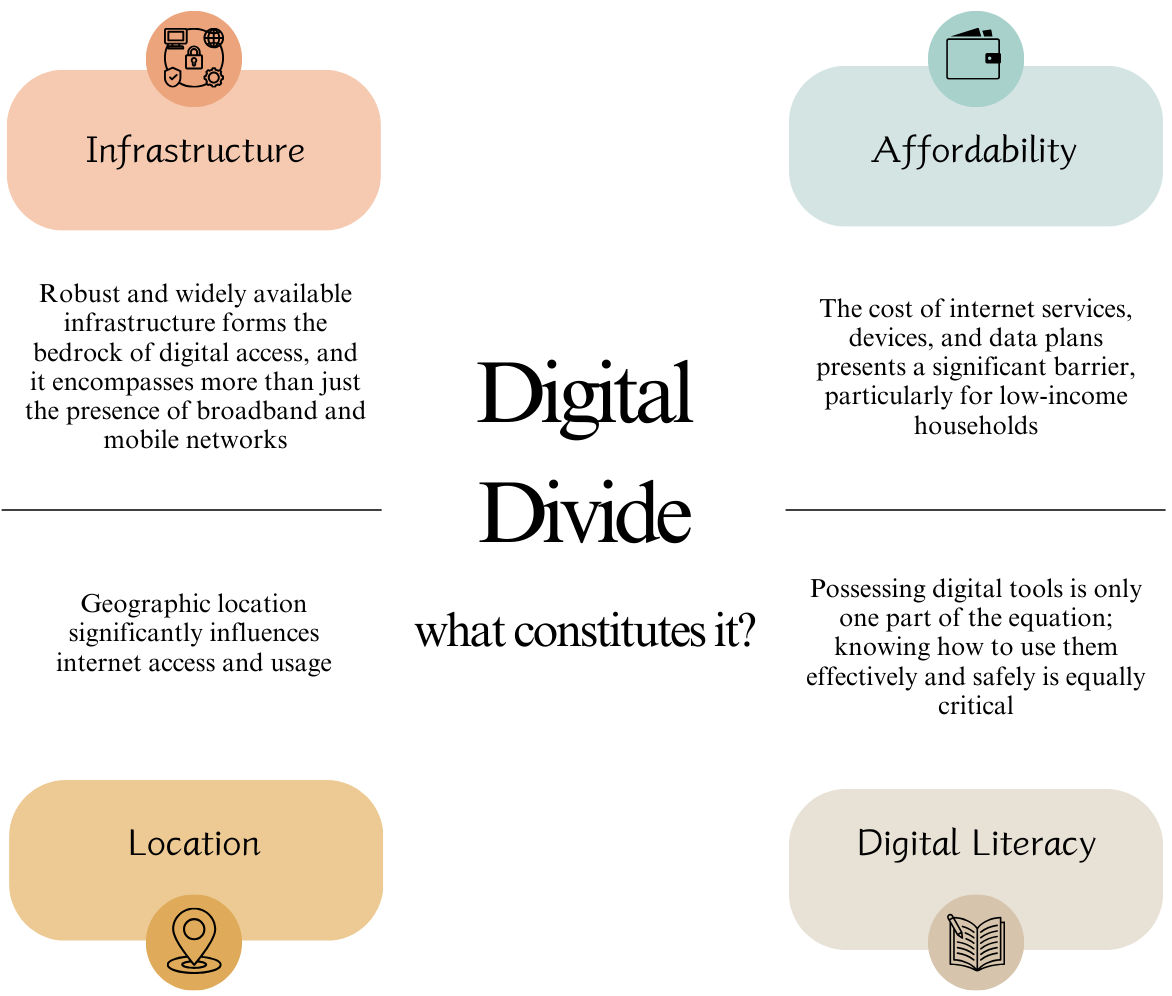Understanding the Digital Divide in the age of AI: Where is the Gap?
The digital divide is about more than just owning a smartphone or having an internet connection; it's about the disparities in opportunities, information, and resources that arise from this gap

October 9, 2024
In today's AI-driven world, access to digital resources has become as essential as access to basic necessities. The digital divide, simply put, is the gap between those who have access to these digital technologies and those who don't. However, this definition merely scratches the surface of a complex issue with far-reaching consequences. It's about more than just owning a smartphone or having an internet connection; it's about the disparities in opportunities, information, and resources that arise from this gap. [1,2,3]
What Constitutes the Digital Divide?

The digital divide is not a monolithic entity. It encompasses various facets, manifesting differently across regions and demographic groups. Let's break down the key elements:
- Infrastructure: Robust and widely available infrastructure forms the bedrock of digital access, and it encompasses more than just the presence of broadband and mobile networks, particularly in remote and underserved regions [4]. The speed, reliability, and quality of these networks are equally crucial in effectively bridging the digital divide [4]. However, simply achieving widespread internet access, even through technologies like fiber, radio, and satellite, doesn't signify the end of the digital divide. While 95% of the global population might be within reach of internet access, the quality and affordability of this access vary greatly, presenting ongoing challenges:
- Fluctuating Bandwidth: The digital divide, measured in terms of bandwidth, isn't steadily closing [1]. Instead, it fluctuates with each technological innovation. While the introduction of broadband initially widened the gap, later advancements like 5G and fiber optics have shown potential in reducing this disparity. This suggests that simply expanding access isn't enough; the capacity and speed offered by the infrastructure are crucial for meaningful connectivity.
- The Urban-Rural Gap: The disparity in internet speeds between urban and rural areas [1]. Larger cities often have better access to high-speed internet, while rural areas might have limited or no service. This disparity stems from a lack of infrastructure investment in these areas, often due to the higher costs and lower profitability for service providers.
- Uneven Distribution of Infrastructure: The global inequality in the distribution of installed telecommunication bandwidth [5]. A handful of countries, primarily developed nations, hold a disproportionately large share of global bandwidth. This uneven distribution of infrastructure directly impacts internet speed and quality, leaving developing countries at a disadvantage.
- Beyond Physical Infrastructure: Addressing the digital divide requires considering various forms of access beyond physical infrastructure [5]. While having broadband and mobile networks is crucial, ensuring their affordability and equipping individuals with the skills to utilize them effectively are equally important. This means that infrastructure development must be complemented with policies and programs that promote affordability, digital literacy, and relevant content creation. In essence, digital access is not just about connecting people; it's about connecting them effectively and equitably. This requires a holistic approach that considers not only the physical infrastructure but also the quality of connections, affordability for all, and the development of necessary skills and content to leverage the internet's full potential..
- Affordability: The cost of internet services, devices, and data plans presents a significant barrier, particularly for low-income households. As highlighted by the Internet Poverty Index (IPI), affordability is a critical pillar of internet poverty, with a benchmark set at individuals spending no more than 10% of their expenses on mobile internet. The high cost of connectivity fees disproportionately impacts low-income households and hinders digital inclusion efforts. [6, 7, 8]
- Digital Literacy: Possessing digital tools is only one part of the equation; knowing how to use them effectively and safely is equally critical. Digital literacy goes beyond basic computer skills; it involves understanding online safety, critically evaluating online information, and leveraging digital tools for personal and professional growth. This emphasizes the need for education and digital skills training to bridge the knowledge gap alongside the infrastructure gap. [4, 9]
- Location: Geographic location significantly influences internet access and usage. The urban-rural divide is stark, with urban areas generally enjoying better connectivity compared to suburban and rural regions. This disparity stems from challenges in extending infrastructure to remote areas and the lower profitability for service providers in these regions. For instance, in Latin America, while 67% of urban households have internet access, this figure drops to a mere 23% in rural areas. [3, 9, 10]
Beyond Access: The Expanding Definition of the Digital Divide
As technology evolves and internet penetration increases, the very definition of the digital divide is expanding. Researchers and policymakers are increasingly focusing on the qualitative aspects of internet use and the disparities in utilizing digital tools for content creation and participation in the digital economy. This shift in focus has led to the emergence of concepts like the knowledge divide and the second-level digital divide, also known as the production gap [11].
The knowledge divide underscores the difference between having access to information and having the skills to interpret, analyze, and utilize that information effectively. It acknowledges that merely being online doesn't automatically translate to being digitally literate or capable of harnessing the full potential of the internet. [3]
Similarly, the second-level digital divide highlights the disparity between those who consume content online and those who create it. While Web 2.0 technologies have empowered users to become content creators, a significant portion of user-generated content originates from a small, digitally savvy segment of the population. Factors like the type of internet connection, frequency of access, education levels, and socioeconomic status influence an individual's ability and likelihood to engage in online content creation.
The Ripple Effect: Consequences of the Digital Divide
The consequences of the digital divide extend far beyond the individual, impacting social, economic, and political spheres:
- Perpetuating Inequality: The digital divide has the potential to worsen existing social and economic disparities, creating a vicious cycle of disadvantage. Those without access to technology and digital skills are often left behind, lacking opportunities for education, employment, and social mobility. This gap can lead to reduced lifetime earnings, limited access to healthcare information, and exclusion from government services, further marginalizing vulnerable communities. [2, 10, 12]
- Widening the Education Gap: Students without internet access and digital literacy skills face significant obstacles in their learning journey. The "homework gap," which gained significant attention during the COVID-19 pandemic, highlights how a lack of home internet access can hinder a student's ability to complete assignments, access online learning resources, and participate fully in digital learning environments. In the United States, for instance, a significant percentage of students, especially those from low-income backgrounds, lack adequate broadband internet access at home, impacting their academic performance and future prospects. [9]
- Stifling Economic Growth: The digital divide can hinder economic growth, particularly in developing countries. Lack of access to information, online markets, and digital tools for businesses can limit innovation, entrepreneurship, and overall economic productivity. In contrast, bridging the divide can unlock new markets, create job opportunities, and foster economic development. [12]
Building Bridges: Strategies to Address the Digital Divide
Tackling the multi-dimensional challenge of the digital divide demands a collaborative approach involving governments, the private sector, and civil society organizations. Let's talk about some key strategies:
- Prioritizing Infrastructure Development: Expanding broadband and mobile network infrastructure, especially in underserved and remote areas, is crucial. This requires investments from governments and private companies, along with policy measures that promote infrastructure sharing, streamline approval processes for network deployment, and incentivize private sector participation in underserved areas. Initiatives like attaching network build-out obligations for underserved areas to 4G and 5G spectrum licenses can encourage service expansion. [8, 12, 13]
- Making Internet Access Affordable: Reducing the cost barrier to internet access is essential for digital inclusion, especially for low-income households. Governments can explore options like providing subsidies for internet costs, reducing taxes on low-cost internet-capable devices, and implementing financial incentives for network operators to expand services to underserved regions. Fostering competition among service providers through regulatory measures can also contribute to more affordable internet services. [6, 9]
- Empowering Through Digital Literacy: Equipping individuals with the necessary digital skills is as vital as providing access to technology. Educational programs focused on digital literacy should be implemented in schools, community centers, and online platforms to reach diverse populations. These programs should not only cover basic computer skills but also encompass critical thinking about online information, responsible digital citizenship, and the use of digital tools for personal and professional growth. [3, 4, 9]
- Designing for Inclusivity: Technology should be designed with accessibility in mind, catering to the needs of diverse users, including those with disabilities, varying levels of digital literacy, and language barriers. This involves promoting inclusive design principles, developing assistive technologies, and ensuring digital content is accessible in multiple languages and formats. [12, 13]
- Leveraging Public-Private Partnerships: Collaboration between governments, NGOs, and private entities can leverage resources, expertise, and successful models for greater impact. Public-private partnerships can be particularly effective in rolling out infrastructure projects, conducting digital literacy campaigns, and developing innovative and affordable access solutions. [8, 13]
The Path Forward: A Collective Responsibility
Bridging the digital divide is not a one-size-fits-all solution. It requires context-specific strategies, continuous evaluation, and a commitment to inclusivity. It's about recognizing that access to digital technologies is not a luxury but a fundamental right in today's world, essential for individual empowerment, economic growth, and social progress. [4, 7, 11, 14]
In conclusion, the digital divide is a complex issue with profound implications. It's a global challenge requiring collective action from governments, private sectors, and civil society to create a more equitable and inclusive digital future where everyone has the opportunity to thrive in the digital age. [4, 15]
References
[1] Digital Divide. Wikipedia. Last edited October 2, 2024.
[2] Toward Bridging the Data Divide. World Bank. September 5, 2023.
[3] What Is the Digital Divide?. IEEE. December 14, 2022.
[4] Bridging the Digital Divide: A Comprehensive Analysis of Global Internet Connectivity. The CDO Times. November 17, 2023.
[5] Global Digital Divide. Wikipedia. Last edited September 1, 2024.
[6] Internet Poverty Index: more than 1 billion people live in Internet poverty worldwide. Internet Society Foundation. May 19, 2023.
[7] Missed Connections: An incomplete digital revolution in Latin America and the Caribbean. UNPD. August 4, 2024.
[8] Poor digital access is holding Latin America and the Caribbean back. Here’s how to change it. World Bank. August 12, 2021.
[9] The Digital Divide: How Tech Can Bridge the Gap in Latin America. The Borgen Project. October 5, 2023.
[10] Latin America's Digital Divide: Overcoming Persistent Gaps. Wilson Center. 2021.
[11] Implications of the Digital Transformation on Different Social Groups. European Parliament. March 2024.
[12] Access and skills training: The actions that will help us close the digital divide effectively World Economic Forum. Jan 11, 2024.
[13] How can we bring 2.6 billion people online to bridge the digital divide? World Economic Forum. Jan 14, 2024.
[14] The Internet Poverty Index: Infographic. World Data Lab. April 19, 2024.
[15] Widening Digital Gap between Developed, Developing States Threatening to Exclude World’s Poorest from Next Industrial Revolution, Speakers Tell Second Committee. United Nations. October 6, 2023.
